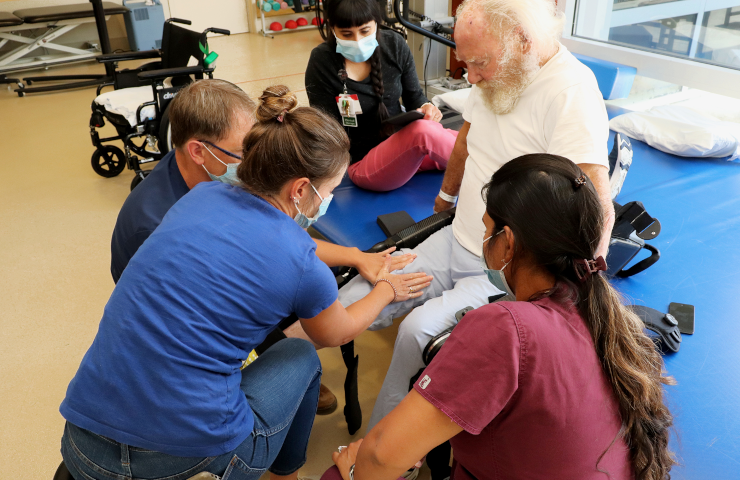Natividad’s Robotic Exoskeleton is Helping Stroke and Spinal Injury Patients Stand and Walk Again
- September 2, 2020

Natividad Sam Karas Acute Rehabilitation Patient Michael Rawlings recently volunteered to get strapped into a device that can only be described as something out of a science fiction movie.
Shiny stainless steel coupled with hydraulics and black Velcro straps encased his legs. A device strapped around his midsection resembled an extra-large industrial back support belt often used by workers and weightlifters.
Physical Therapist Sudha Shorian placed a walker in front of Rawlings. He grabbed it with both hands. Another physical therapist adjusted Rawlings’ legs. Then, Rawlings slowly leaned forward.
That’s when the device Rawlings was strapped into sprang into action. With a loud clicking noise, the robotic exoskeleton propelled Rawlings upright. A few minutes later, he was taking small steps. It was the first time Rawlings had walked in a month, following three back surgeries over three decades.
Indego® is an adjustable lower limb exoskeleton device that enables stroke and spinal cord injury patients, and those with other debilitating neuromuscular disorders, to stand and walk early on in their rehab. The artificial intelligence robotic device, once strapped to the patient’s waist and legs, can help patients like Rawlings go from sitting to standing and walking. These are patients who would otherwise be unable to do either of these activities following spinal cord injuries, stroke and other issues.
Shorian is among several physical therapists at Natividad’s award-winning rehabilitation unit using the state-of-the-art $125,000 FDA-approved device to provide gait therapy, a type of physical therapy that improves a patient’s ability to stand and walk, for patients with lower extremity weakness. The software for the exoskeleton operates through an app on her smartphone. The software offers a variety of options, settings and analytics on patient and device performance that clinicians can use to improve treatment plans in real-time, allowing tailored treatment for each client. Therapists can also log into a dashboard so they can track a patient’s progress over time.
Shorian explained that using the robotic device helps patients stand up sooner, which prevents patients from losing range of motion and bone density and has the added benefit of helping maintain blood pressure and cardiovascular health. It can also help with recovery time, decreasing pain and regaining confidence.
“We are very excited to use the Indego Therapy exoskeleton on our patients and help them accelerate their road to recovery,” Shorian said. “Many of our patients haven’t stood or walked for months or years. This device is getting them upright and mobile, which has a tremendous benefit on their overall health and medical outcomes.”
